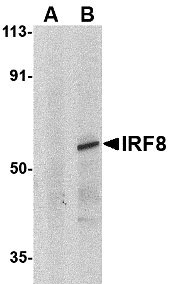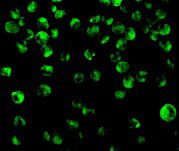IRF8 Antibody
- 产品详情
- 实验流程
- 背景知识
Application
| WB, IF, E |
|---|---|
| Primary Accession | Q14653 |
| Other Accession | NP_002154, 4504567 |
| Reactivity | Human, Mouse, Rat |
| Host | Rabbit |
| Clonality | Polyclonal |
| Isotype | IgG |
| Calculated MW | 47219 Da |
| Concentration (mg/ml) | 1 mg/mL |
| Conjugate | Unconjugated |
| Application Notes | IRF8 antibody can be used for detection of IRF8 by Western blot at 1 µg/mL. For immunofluorescence start at 10 µg/mL. |
| Gene ID | 3661 |
|---|---|
| Other Names | IRF8 Antibody: Interferon regulatory factor 3, IRF-3, interferon regulatory factor 3 |
| Target/Specificity | IRF3; |
| Reconstitution & Storage | IRF8 antibody can be stored at 4℃ for three months and -20℃, stable for up to one year. As with all antibodies care should be taken to avoid repeated freeze thaw cycles. Antibodies should not be exposed to prolonged high temperatures. |
| Precautions | IRF8 Antibody is for research use only and not for use in diagnostic or therapeutic procedures. |
| Name | IRF3 {ECO:0000303|PubMed:9803267, ECO:0000312|HGNC:HGNC:6118} |
|---|---|
| Function | Key transcriptional regulator of type I interferon (IFN)- dependent immune responses which plays a critical role in the innate immune response against DNA and RNA viruses (PubMed:22394562, PubMed:24049179, PubMed:25636800, PubMed:27302953, PubMed:31340999, PubMed:36603579, PubMed:8524823). Regulates the transcription of type I IFN genes (IFN-alpha and IFN-beta) and IFN-stimulated genes (ISG) by binding to an interferon-stimulated response element (ISRE) in their promoters (PubMed:11846977, PubMed:16846591, PubMed:16979567, PubMed:20049431, PubMed:32972995, PubMed:36603579, PubMed:8524823). Acts as a more potent activator of the IFN-beta (IFNB) gene than the IFN-alpha (IFNA) gene and plays a critical role in both the early and late phases of the IFNA/B gene induction (PubMed:16846591, PubMed:16979567, PubMed:20049431, PubMed:36603579). Found in an inactive form in the cytoplasm of uninfected cells and following viral infection, double-stranded RNA (dsRNA), or toll-like receptor (TLR) signaling, is phosphorylated by IKBKE and TBK1 kinases (PubMed:22394562, PubMed:25636800, PubMed:27302953, PubMed:36603579). This induces a conformational change, leading to its dimerization and nuclear localization and association with CREB binding protein (CREBBP) to form dsRNA-activated factor 1 (DRAF1), a complex which activates the transcription of the type I IFN and ISG genes (PubMed:16154084, PubMed:27302953, PubMed:33440148, PubMed:36603579). Can activate distinct gene expression programs in macrophages and can induce significant apoptosis in primary macrophages (PubMed:16846591). In response to Sendai virus infection, is recruited by TOMM70:HSP90AA1 to mitochondrion and forms an apoptosis complex TOMM70:HSP90AA1:IRF3:BAX inducing apoptosis (PubMed:25609812). Key transcription factor regulating the IFN response during SARS-CoV-2 infection (PubMed:33440148). |
| Cellular Location | Cytoplasm. Nucleus Mitochondrion. Note=Shuttles between cytoplasmic and nuclear compartments, with export being the prevailing effect (PubMed:10805757, PubMed:35922005). When activated, IRF3 interaction with CREBBP prevents its export to the cytoplasm (PubMed:10805757). Recruited to mitochondria via TOMM70:HSP90AA1 upon Sendai virus infection (PubMed:25609812). |
| Tissue Location | Expressed constitutively in a variety of tissues. |
For Research Use Only. Not For Use In Diagnostic Procedures.
Provided below are standard protocols that you may find useful for product applications.
BACKGROUND
IRF8 Antibody: Interferons (IFN)s are involved in a multitude of immune interactions during viral infections and play a major role in both the induction and regulation of innate and adaptive antiviral mechanisms. During infection, host-virus interactions signal downstream molecules such as transcription factors such as IFN regulatory factor-3 (IRF3) which can act to stimulate transcription of IFN-alpha/beta genes. Unlike IRF3, IRF8 appears to act as a negative regulator of IFN-induced genes in most cases, but IRF8 mediates activation of NF-κB by the toll-like receptor 9 (TLR9) after stimulation by unmethylated CpG DNA in dendritic cells. Finally, it has been shown that IRF8 decreases bcl-2 expression and thus may play a role in chronic myelogenous leukemia.
REFERENCES
Malmgaard L. Induction and regulation of IFNs during viral infections. J. Interferon & Cyto. Res. 2004; 24:439-54
Weisz A, Marx P, Sharf R, et al. The human interferon consensus sequence binding protein (H-ICSBP) is a negative regulator of enhancer elements common to interferon inducible genes. J. Biol. Chem. 1992; 267:25589-96.
Nelson N, Marks MS, Driggers PH, et al. Interferon consensus sequence-binding protein, a member of the interferon regulatory factor family, suppresses interferon-induced gene transcription. Mol. Cell. Biol. 1993; 13:588-99.
Tsujimura H, Tamura T, Kong HJ, et al. Toll-like receptor 9 signaling activates NF-κB through IFN regulatory factor-8/IFN consensus sequence binding protein in dendritic cells. J. Immunol. 2004; 172:6820-7.
终于等到您。ABCEPTA(百远生物)抗体产品。
点击下方“我要评价 ”按钮提交您的反馈信息,您的反馈和评价是我们最宝贵的财富之一,
我们将在1-3个工作日内处理您的反馈信息。
如有疑问,联系:0512-88856768 tech-china@abcepta.com.























 癌症的基本特征包括细胞增殖、血管生成、迁移、凋亡逃避机制和细胞永生等。找到癌症发生过程中这些通路的关键标记物和对应的抗体用于检测至关重要。
癌症的基本特征包括细胞增殖、血管生成、迁移、凋亡逃避机制和细胞永生等。找到癌症发生过程中这些通路的关键标记物和对应的抗体用于检测至关重要。 为您推荐一个泛素化位点预测神器——泛素化分析工具,可以为您的蛋白的泛素化位点作出预测和评分。
为您推荐一个泛素化位点预测神器——泛素化分析工具,可以为您的蛋白的泛素化位点作出预测和评分。 细胞自噬受体图形绘图工具为你的蛋白的细胞受体结合位点作出预测和评分,识别结合到自噬通路中的蛋白是非常重要的,便于让我们理解自噬在正常生理、病理过程中的作用,如发育、细胞分化、神经退化性疾病、压力条件下、感染和癌症。
细胞自噬受体图形绘图工具为你的蛋白的细胞受体结合位点作出预测和评分,识别结合到自噬通路中的蛋白是非常重要的,便于让我们理解自噬在正常生理、病理过程中的作用,如发育、细胞分化、神经退化性疾病、压力条件下、感染和癌症。







